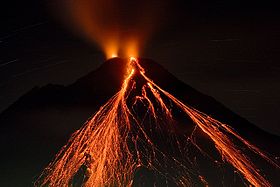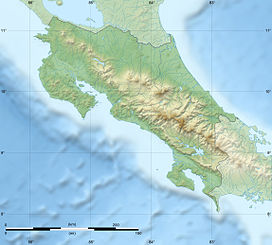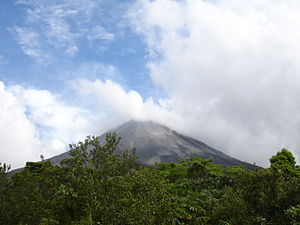- Arenal Volcano
-
Arenal 
Arenal in November 2006Elevation 1,670 m (5,479 ft) [1] Location Alajuela Province, Costa Rica Coordinates 10°27′48″N 84°42′12″W / 10.46333°N 84.70333°WCoordinates: 10°27′48″N 84°42′12″W / 10.46333°N 84.70333°W Geology Type Stratovolcano with lava domes Age of rock 7,000 Last eruption 1984–2010 (continually active) Arenal Volcano, in Spanish Volcán Arenal, is an active andesitic stratovolcano in north-western Costa Rica around 90 km northwest of San José, in the province of Alajuela, canton of San Carlos, and district of La Fortuna. The Arenal volcano measures at least 1,633 metres (5,358 ft),.[2] It is conically shaped with a crater spanning 140 metres (460 ft). Arenal is geologically considered a young volcano and the age is estimated to be less than 7,000 years.[3] It is also known as "Pan de Azúcar", "Canaste", "Volcan Costa Rica", "Volcan Río Frío" or "Guatusos Peak".[1]
The volcano was dormant for hundreds of years and exhibited a single crater at its summit, with minor fumaroles activity, covered by dense vegetation. In 1968 it erupted unexpectedly, destroying the small town of Tabacón. Due to the eruption three more craters were created on the western flanks but only one of them still exists today.
Contents
Geographic setting and description
Arenal was Costa Rica's most active volcano until 2010, and one of the ten most active volcanoes in the world. It has been studied by seismologists for many years. Although the activity nowadays is less damaging, you can still see ash columns, underground rumbling, glowing orange lava flows and sudden explosions on a daily basis. With its perfect conical shape it allows breathtaking views of volcanic action in the summit. Almost every night the crater offers a spectacle of lights with its explosive eruptions.[4]
The volcano is located at the center of Arenal Volcano National Park in the northern zone of the country, 15 kilometres (9.3 mi) southwest of the La Fortuna district in San Carlos Canton, Costa Rica.[5] The temperature varies from 16 °C (61 °F) in the high areas to 24 °C (75 °F) in the low areas and the annual rainfall is around 500 centimetres (200 in).[citation needed]
Arenal Volcano area is an important watershed for the Arenal Lake Reservoir. The reservoir's water is used for hydroelectric power. It is also connected to the national system.[6]
 Arenal Volcano from across Lake Arenal. Arenal is one of seven historically active Costa Rican volcanoes along with Poás, Irazú, Miravalles, Orosí, Rincón de la Vieja complex, and Turrialba.
Arenal Volcano from across Lake Arenal. Arenal is one of seven historically active Costa Rican volcanoes along with Poás, Irazú, Miravalles, Orosí, Rincón de la Vieja complex, and Turrialba.
Subfeatures
Arenal has a good number of eruptive vents.[citation needed] Chato is a dormant stratovolcanic cone. It is believed Chato first erupted 38,000 years ago during the Pleistocene period and last erupted about 3,500 years ago.[3] Chatito 10°26′17″N 84°41′13″W / 10.438°N 84.687°W is a lava dome with an elevation of 1,100 metres (3,609 ft). Espina is another lava dome.[1]
Geologic history
Arenal is the youngest and most active of all the mountains in Costa Rica. Scientists have been able to date its activity back to more than 7000 years ago. The area remained largely unexplored until 1937, when a documented expedition took place to reach the summit.[7] It has been considered eruptive since 1968.[8]
July 29, 1968
At about 7:30 a.m. a powerful eruption took place and destroyed the west flank of the volcano. Three additional craters were formed. The town of Tabacón was buried, killing seventy-eight people.
June 1975
Between the 17th and the 21st of June 1975 several avalanches went down from one of the craters. The vegetation along Tabacon River was destroyed and a great amount of material was deposited on the riverbed. Four strong explosions also blew large amounts of ash into the sky. The ash was spread within a distance of 26 kilometers (16 mi).
June 1984
After a period of high effusive activity of intermittent lava flows, a new explosive phase began with 3 to 20 explosions per day of low to moderate magnitude. These explosions of steam, water, gases and ash reached altitudes of up to 5 kilometers where winds again carried the material across the Arenal reservoir (Lake Arenal) and over the town of Tilarán.
August 1993
A northwest wall of one of the craters collapsed and generated several pyroclastic flows. The collapsed crater wall was shaped as a V, about 60 meters deep and 100 meters wide. In this V-shaped crater the lava started to flow again.
March 1994
Flows started to fill the V-shaped crater and deposited materials around the crater.
March 1996
At this time the volcano started to produce regular lava flows, accompanied by intermittent explosions of gases. This was the regular activity of the volcano until May 5, 1998.
May 5, 1998
The Arenal Volcano experienced a series of large eruptions on Tuesday afternoon, May 5, 1998. The first eruption was recorded at 1.05 p.m. when part of the northwest wall of the crater fell apart. Large amounts of lava, rocks and ash flew out of the volcano during this explosion. Another eruption took place at 2.20 p.m. with material emerging from the same part of the volcano.
A specialist from the Costa Rica Volcanic and Seismic Observatory explained that the happening is nothing unusual for the volcano. Nevertheless, during this occasion the amount of lava within the crater was significantly greater than normal and therefore more material was poured out. This time a landslide (avalanche) took place, too, as a part of the crater wall fell apart on the northwest side. The phenomenon occurs sporadically, although this time the consequences were greater than usual.
As a normal precaution, authorities declared a red alert, closed the road between La Fortuna and Tilarán, which runs around the north side of the volcano, and evacuated approximately 450 people (mostly tourists) from the immediate area including several hotels and tourism oriented businesses. There were no reports of injuries caused by the volcanic activity.
At 5.20 p.m. on Tuesday the volcano was still discharging material, but activity had decreased significantly.
May 7, 1998
The eruptions of May 7, 1998 damaged two square kilometers and destroyed a 400- by 100-meter area of green forest in the vicinity of Arenal Volcano. A fissure, 500 meters long and 10 meters deep, was opened up in the wall of the crater and all the material slid down the side of the volcano.
During this day 23 eruptions were reported, between 1:05 p.m. and 7:00 p.m., and thereafter the volcano returned to its normal state. Authorities reported no unusual behavior and the national park was reopened the same week. Local seismologists investigate the activity of the volcano and park rangers continue to vigorously enforce the safety perimeter.
See also
References
- ^ a b c "Arenal - Synonyms and Subfeatures". Global Volcanism Program, Smithsonian Institution. http://www.volcano.si.edu/world/volcano.cfm?vnum=1405-033&volpage=synsub. Retrieved 2009-10-11.
- ^ "Arenal" (in Spanish). Costa Rican Vulcanologic and Seismologic Observatory. http://www.ovsicori.una.ac.cr/vulcanologia/volcanes/arenal.htm. Retrieved 2009-10-11.
- ^ a b "Arenal". Global Volcanism Program, Smithsonian Institution. http://www.volcano.si.edu/world/volcano.cfm?vnum=1405-033. Retrieved 2009-10-11.
- ^ http://www.arenal.net/
- ^ http://www.arenal.net/arenal-volcano-overview.htm
- ^ http://www.arenal.net/lake-arenal-dam.htm
- ^ http://www.CostaRica21.com/Arenal-Volcano.html#Facts_&_Data
- ^ "Arenal - Eruptive History". Global Volcanism Program, Smithsonian Institution. http://www.volcano.si.edu/world/volcano.cfm?vnum=1405-033&volpage=erupt. Retrieved 2009-10-11.
External links
- MTU Volcanoes Page: Arenal
- Updated (and detailed) information and images about Arenal and its recent activity
- Most recent pictures of Arenal eruptions
- Jorque Barquero's Personal Account of the 1968 Eruption
- Fortuna (Costa Rica) travel guide from Wikitravel
Volcanoes of Costa Rica Cordillera de Guanacaste Cordillera de Tilarán Arenal · ChatoCordillera Central Categories:- Stratovolcanoes
- Subduction volcanoes
- Volcanoes of Costa Rica
- Mountains of Costa Rica
- Active volcanoes
Wikimedia Foundation. 2010.




